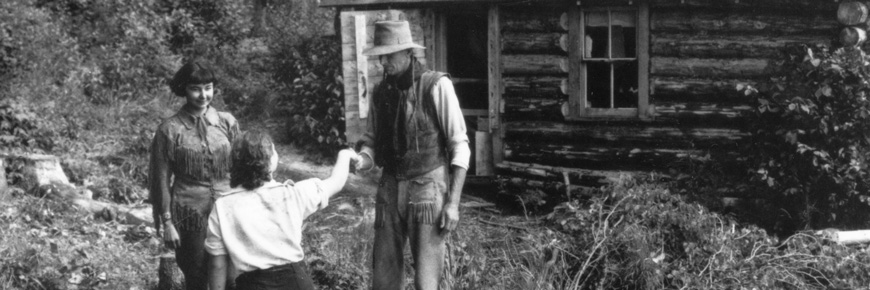
Gertrude Bernard, Archibald Belaney, and anonymous tourist at Ajawaan Lake, Prince Albert National Park, 1933.
Photographed by W.J. Oliver.
Archibald Belaney and Gertrude Bernard (Grey Owl and Anahareo)
Prince Albert National Park
The English author and conservationist Archibald Belaney (who called himself Grey Owl) and his Mohawk wife Gertrude Bernard (also known as Anahareo) lived and worked in Riding Mountain and Prince Albert National Parks in the 1930s. While working for these parks, Belaney passed himself off as Indigenous. He believed that his words would have a bigger impact on settler Canadians coming from an “Indigenous” person. As expressed in his many public lectures and books, his conservation philosophy aligned well with contemporary national park ideas. After a short period of time working for Riding Mountain National Park in 1931, Belaney and Anahareo moved with their pet beavers, Jelly Roll and Rawhide, to Ajawaan Lake in Prince Albert National Park. Belaney wrote three books while living on Ajawaan, and hundreds of visitors made the trek to see and speak with him, and to see their pet beavers. In 1935 and 1937, he made hugely successful lecture tours of Britain, promoting his books and his ideas on conservation.
Upon his death in 1938, a newspaper revealed Belaney’s truth: he was an Englishman named Archibald Belaney, not an Indigenous man named Grey Owl as he had claimed. His national park employers and the public were shocked, but many Indigenous people who had met him had strong suspicions about his ancestry claims. Belaney presented a romanticized image of what the public expected of an “Indian,” establishing himself in the minds of the Canadian public as a natural conservationist because of his supposed Indigenous background. In lying about his ancestry, Belaney also falsely represented himself as a spokesperson for Indigenous peoples and their worldviews. His words and works were praised by the Canadian and English public at a time when Indigenous people from the communities surrounding Prince Albert National Park faced racist and discriminatory government policies. At the same time that Belaney lived in the park, in his cabin on Ajawaan Lake, Indigenous people were prevented from accessing their territories and resources within the park’s borders and their activities were criminalized.
Gertrude Bernard, who came to be known as Anahareo, was a Mohawk woman from Mattawa, Ontario. According to her writings, she believed her husband’s claims of Indigenous ancestry. During the time they were together she, along with the two pet beavers she saved, helped change his mind about beavers, setting him on the path from trapping to conservation. Anahareo was a prospector and able canoeist; when she lived in the park in the 1930s she could use the interconnected waterways to paddle directly from Waskesiu Lake, through to Montreal Lake, Lac La Ronge, on northwards past Wollaston Lake, eventually on to Reindeer Lake and finally Flin Flon, Manitoba. Anahareo was a published author in her own right and wrote an account of her life called Devil in Deerskins. In 1983, Anahareo was inducted into the Order of Canada for a lifetime of work in animal rights, having campaigned to ban the leg-hold trap and the poisoning of wolves. She passed away in 1985.
Belaney’s work to promote conservation was tarnished and he remains a controversial figure to this day because of the revelation of his cultural appropriation. However, his and Anahareo’s conservation efforts with beaver and their writings inspired people across the world to protect landscapes like Prince Albert National Park.
Belaney, Anahareo, and their daughter Shirley Dawn are all buried near their cabins on Ajawaan Lake in Prince Albert National Park.
Click below to learn more about the history of this region:
- Date modified :